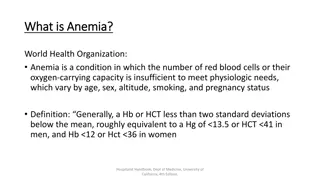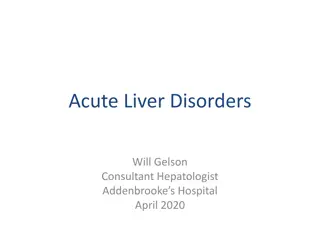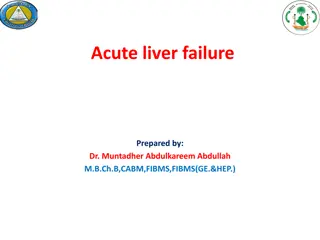Understanding Acute Visual Loss: Causes and Evaluation
Loss of vision can occur suddenly, affecting one or both eyes and various parts of the visual field. This guide explores the definition, pathophysiology, and evaluation of acute visual loss. Common causes include optic nerve diseases, retinal disorders, and vascular issues. The visual pathway from the cornea to the primary visual cortex is discussed along with history-taking and physical exam considerations. By understanding the different etiologies, healthcare providers can properly screen and manage patients with acute visual loss.
Download Presentation

Please find below an Image/Link to download the presentation.
The content on the website is provided AS IS for your information and personal use only. It may not be sold, licensed, or shared on other websites without obtaining consent from the author. Download presentation by click this link. If you encounter any issues during the download, it is possible that the publisher has removed the file from their server.
E N D
Presentation Transcript
Index: Acute visual loss 1. Introduction/Definition 2. Pathophysiology 3. Taking History 4. Physical exam/Special tests 5. Common Etiologies and examples of Acute visual loss
Introduction Definition: Loss of vision is usually considered acute if it develops within a few minutes to a couple of days. It may affect one or both eyes. 1. 2. All or part of the visual field. 3. Arise from pathology of any part of the visual pathway
The Visual Pathway Cornea Anterior Chamber Lens Iris Vitreous Retina
The Visual Pathway RGCs *Phototransduction: By photoreceptors (rods and cones) *Image processing: By horizontal, bipolar , amacrine and RGC *Output to optic nerve: By RGCs and nerve fiber layer NFL
The Visual Pathway Retina Optic Nerve Optic Chiasm tic Chiasm Visual Pathway Lateral Geniculate Nucleus Primary Visual Cortex
Mind Map Acute visual loss History taking Physical exam Acute discovery of chronic visual loss Optic nerve disease Visual pathway disorder Functional visual loss Media opacity Retinal disease hysterical OR malingering Corneal edema/ulcer Retinal Detachment Vascular etiology Optic neuritis Stroke/tumor Unilateral usuallly Cortical blindness OR VF loss Vitreous hemorrhage CRAO/CRVO hyphema
The Visual Pathway Cornea Anterior Chamber Lens Iris Vitreous Retina
The Visual Pathway Retina Optic Nerve Optic Chiasm tic Chiasm Visual Pathway Lateral Geniculate Nucleus Primary Visual Cortex
Objectives The student should be able to: 1. Properly screen and evaluate patients presenting with acute visual loss. 2. Understand the pathophysiology and identify common causes of acute visual loss. 3. Recognize situations requiring urgent ophthalmic care to prevent permanent visual loss.
Initial activity What are the important questions to ask in history for a patient with acute visual loss?
Content: History 1. Is the visual loss transient or persistent? 2. Is the visual loss monocular or binocular? 3. Did the visual loss occur suddenly or it developed over hours, days or weeks? 4. What is the patient s age and general medical condition? 5.Did the patient have normal vision in the past and when was vision last tested 5. Some people will only realize loss of vision from one eye; when they cover the good eye. 6. Is it painful or painless?
Content: History 1) transient or persistent: Migraine vs Retinal detachment 2) monocular or binocular: Optic neuritis vs Cortical blindness 3) hours, days or weeks: CRAO vs Retinal detachment 4) patient s age: Acute Glaucoma vs Corneal abrasion 5) Contact lens use: corneal ulcer 6) Painless visual loss: Vitreous hemorrhage, retinal detachment 7) Painful visual loss: Acute glaucoma, Keratitis
Causes of Acute Visual Loss PAINFUL PAINLESS Acute Glaucoma Uveitis Keratitis Hyphema (Traumatic) Vitreous Hemorrhage Retinal Detachment Retinal vascular occlusions Optic neuritis + Ischemic optic neuropathy CVA Functional
Content: Physical exam and special tests 1) Visual acuity testing 2) Confrontation visual fields test 3) Pupillary reactions 4) External examination of the eye with a pen light 5) Slit lamp examination 6) Ophthalmoscopy exam 7) Tonometry to measure the intraocular pressure
Content: Common causes of acute visual loss 1) Corneal ulcer 2) Acute angle closure glaucoma 3) Central retinal artery occlusion 4) Central retinal vein occlusion 5) Retinal detachment 6) Vitreous hemorrhage 7) Optic neuritis 8) Occipital stroke
Acute visual loss: Media opacities Corneal edema: When the cornea appears like ground glass rather than its normal clear appearance. The most common cause of corneal edema is increased intraocular pressure typically in angle closure glaucoma. Any acute infection of the cornea resulting in a corneal ulcer may mimic corneal edema
Acute visual loss: Media opacities Corneal ulcer: When there is a corneal opacity due to destruction of tissue by infiltration of microorganisms and WBCs. Could be viral, bacterial, fungal, protozoal or neurotrophic in etiology
Acute visual loss: Media opacities Hyphema: Hyphema is blood in the anterior chamber The hyphema is a direct consequence of blunt trauma to a normal eye. However, it can occur with tumors, diabetes, intraocular surgery and chronic inflammation which all cause neovascularization of the anterior segment.
Acute visual loss: Media opacities Vitreous hemorrhage: Any bleeding into vitreous cavity will reduce visual acuity. Can result from: Trauma, Diabetic retinopathy or Retinal vascular occlusion. Rarely, can accompany subarachnoid hemorrhage. If you cannot appreciate a red reflex with an ophthalmoscope B scan ultrasound is important to know the etiology.
Acute visual loss: Retinal diseases Retinal vascular occlusions: Central Retinal artery occlusion: A sudden, painless and often complete visual loss may indicate central retinal artery occlusion. Several hours after a central retinal artery occlusion, the inner layer of the retina becomes opalescent (white). A cherry red spot is seen due to the pallor of the perifoveal retina in contrast to the normal color of the fovea. A chronic cherry red spot is also a feature of the storage diseases such as Tay-Sachs disease and Niemann-Pick disease. There is no generally accepted acute management.
Acute visual loss: Retinal diseases Retinal vascular occlusions: Central Retinal vein occlusion: ophthalmoscopes picture of disc swelling, venous engorgement, cotton wool spots and diffuse retinal hemorrhages like blood and thunder. Loss of vision may be moderate to severe. Treatment should be directed at reducing associated macular edema by injecting anti-vascular endothelial growth factor agents. Visual prognosis depend on degree of associated retinal ischemia.
Acute visual loss: Retinal diseases Retinal Detachment: Could be macula on or macula off complain of flashing lights, large number of floaters, shade or curtain covering the visual field. An afferent pupillary defect The diagnosis is confirmed by ophthalmoscopy through a dilated pupil, and retina appears elevated with folds and the choroid background behind the retina is indistinct.
Acute visual loss: Optic nerve disease Optic Neuritis: Optic Neuritis is inflammation of the optic nerve. It is usually associated with multiple sclerosis and could be the first clinical manifestation. Visual acuity and color vision are markedly reduced with a positive afferent pupillary defect. Associated with pain on extraocular muscle movement in 90% of patients. The optic disc could be hyperemic and swollen, but usually appears normal. The visual acuity usually recovers. however, repeated episodes of optic neuritis may lead to permanent loss of vision.
Acute visual loss: Visual pathway disorders Homonymous hemianopia - is loss of vision on one side of both visual fields may result from occlusion of one of the posterior cerebral arteries with infarction of the occipital lobe. Other vascular abnormalities occurring in the middle cerebral artery distribution may produce a hemianopia, but usually other neurological signs are prominent. Any patient with a hemianopia needs at CT or MRI to localize and identify the cause.
Acute visual loss: Visual pathway disorders Cortical Blindness: A rare bilateral extensive damage to the cortical visual pathways results in complete loss of Vision. This condition is referred to as cortical, central or cerebral blindness. As the pathways serving the pupillary lights reflex are spared, the patient who is cortically blind has normal pupillary reactions. Therefore, a patient with normal fundus examination along with normal pupillary reactions, most likely has cortical blindness..
Acute visual loss: Functional Visual loss Functional visual loss describes vision loss due to hysterical or malingering reasons. ie: not explained by organic basis. A patient may report complete blindness in one eye and normal vision in the other eye, and have no relative afferent pupillary defect. Various techniques exist to confirm functional visual loss.
Final activity Common causes of acute visual loss based on patient s age ?
Final activity Common causes of acute visual loss based on patient s age ? Wet, age related macular degeneration Commotio retinae Rupture globe Orbital cellulitis
Summery Loss of vision is usually considered acute if it develops within a few minutes to a couple of days. 1. It may affect one or both eyes. 2. All or part of the visual field. 3. Arise from pathology of any part of the visual pathway 4. Taking good history and considering the anatomy of the visual pathway is the key for proper evaluation of the patient with acute visual loss.
Quiz 1. A 69-year-old woman presents with acute onset of ocular pain, decreased vision, and halos around lights in the right eye associated with nausea and vomiting. The most likely diagnosis is: Primary open-angle glaucoma a. b. Lens induced glaucoma Pigmentary glaucoma c. d. Acute primary angle-closure glaucoma
Quiz A 30 -year-old woman presents with sudden vision loss of the right eye and mild pain on upgaze movement. Examination reveals that vision is 20/50 on the right and 20/20 on the left. There is a +RAPD on the right and a Visual field testing showed an inferior altitudinal defect on the same side. The left side is normal. Optic discs and fundi are normal in both eyes. What is the most likely diagnosis? 2. Branch retinal vein occlusion a. Anterior ischemic optic neuropathy b. Retrobulbar optic neuritis c. Compressive optic neuropathy d.
Instructions 1) Introduction 9) Middle activity 2) Mind map 10) Content 3) Help 11) Final activity 4) Preface 12) Summary 13) quiz 5) Index 6) Objective 7) Initial activity 8) Content
Mid activity What are some common causes of acute visual loss based on the anatomy of the visual pathway?























